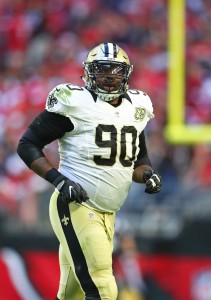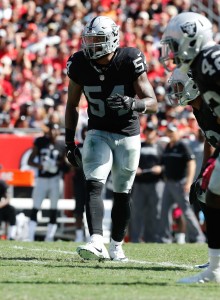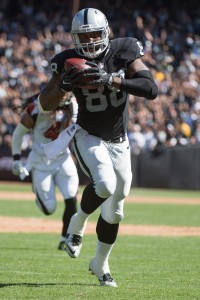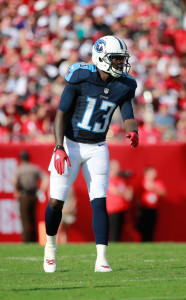In advance of March 9, the start of free agency in the NFL, Pro Football Rumors will detail each team’s three most glaring roster issues. We’ll continue this year’s series with the Oakland Raiders, who ended a 13-season playoff drought by going 12-4 and advancing to the AFC bracket. A historically ill-timed injury to Derek Carr spoiled the Raiders’ realistic chances at making a postseason run, but the team is well-positioned to be a factor for years to come. Whether they’re going to be identified with Oakland or Las Vegas, the Raiders have the pieces to be considered one of the AFC favorites in 2017.
Depth Chart (via Roster Resource)
Pending Free Agents:
- Nate Allen, S
- Denico Autry, DE (RFA)
- Daren Bates, S
- Jon Condo, LS
- SaQwan Edwards, S (ERFA)
- D.J. Hayden, CB
- Andre Holmes, WR
- Gabe Holmes, TE (ERFA)
- Denver Kirkland, G-T (ERFA)
- Stacy McGee, DT
- Matt McGloin, QB
- Latavius Murray, RB
- Perry Riley, LB
- Mychal Rivera, TE
- Seth Roberts, WR (RFA)
- Malcolm Smith, LB
- Brynden Trawick, S
- Menelik Watson, T
Top 10 Cap Hits for 2017:
- Kelechi Osemele, G: $13,200,000
- Sean Smith, CB: $9,500,000
- David Amerson, CB: $8,500,000
- Michael Crabtree, WR: $7,000,000
- Bruce Irvin, LB: $7,000,000
- Rodney Hudson, C: $6,850,000
- Austin Howard, T: $6,400,000
- Amari Cooper, WR: $6,180,151
- Donald Penn, T: $6,100,000
- Khalil Mack, LB/DE: $5,942,683
Other:
- Projected cap space (via OverTheCap): $46,560,487
- 24th pick in draft
- Must exercise or decline fifth-year option for LB Khalil Mack
Three Needs:
1.) Address the defensive interior: Extensions for Derek Carr and, eventually, Khalil Mack will begin to affect the Raiders’ offseason spending after years of the team’s payroll being devoid of homegrown re-ups. But if they were going to make a big outside investment at a position this year, interior defensive line would be a key spot to target. Oakland actually entered training camp in fairly good shape here, but enduring the ignominy of finishing a season with a league-worst 25 sacks despite having a possible defensive player of the year leading that charge will force Reggie McKenzie into addressing this area. Mack and Bruce Irvin delivered 18 of those 25 sacks and give the Raiders their best set of bookend pass-rushers since Howie Long and Greg Townsend during their early Los Angeles days. But they don’t have a lot of help right now.
 Mario Edwards remains an intriguing prospect, but this latest injury — a hip malady that sidelined him for 14 regular-season games after he was initially expected to be shelved for merely a few — showed durability will likely be an issue. He’s now missed 16 games in two years. The Raiders can’t count on him to be the top interior presence he was in 2015, when he graded out as a top-10 run-stopper among edge defenders (per Pro Football Focus). Edwards is the Raiders’ best holdover interior rusher and when available solves multiple problems for a defense that ranked 23rd against ground attacks, but Oakland needs help here.
Mario Edwards remains an intriguing prospect, but this latest injury — a hip malady that sidelined him for 14 regular-season games after he was initially expected to be shelved for merely a few — showed durability will likely be an issue. He’s now missed 16 games in two years. The Raiders can’t count on him to be the top interior presence he was in 2015, when he graded out as a top-10 run-stopper among edge defenders (per Pro Football Focus). Edwards is the Raiders’ best holdover interior rusher and when available solves multiple problems for a defense that ranked 23rd against ground attacks, but Oakland needs help here.
Its investment in Jihad Ward did not reveal a piece ready to make an impact, with the raw second-rounder recording no sacks in 13 starts. PFF tabbed the Illinois product as its worst interior defender. Denico Autry profiles as a backup at best. Stacy McGee finished with 2.5 sacks to lead the uninspiring supporting cast, and he’s a UFA. Oakland uses both 4-3 and 3-4 looks, with new defensive assistant John Pagano likely to implement additional usage of the latter alignment, and has run-stopping DTs Dan Williams and Justin Ellis under contract for 2017. Neither is a high-end option, and Williams’ $4.5MM cap number can be shed entirely to gain more space if the Raiders so choose. But the team will need some incumbents to supplement whatever talent is acquired. However, as the only non-rookie-deal player in this mix, Williams looms as a release candidate.
An issue in upgrading on the D-line could be a lack of realistic options to make any kind of real impact on the UFA market. Kawann Short is unlikely to leave Carolina, and if Calais Campbell manages to make it to the market, he will be seeking a major payday. The 30-year-old dynamo would obviously be a fit, but given the current level at which he’s playing, Campbell could command $10MM per year or close to it on a medium-length deal. That would be a pursuit McKenzie would be wise to be involved in, but again, the Cardinals — who have spent to retain their homegrown defenders — would have to pass on him before the new league year commences. Nick Fairley capitalized on his prove-it deal with the Saints and could have a robust market for his services. Fairley’s career-high 6.5 sacks gave the former first-rounder three seasons of at least 5.5 takdeowns. While he’s not known as being a particularly formidable run-defending presence, the 29-year-old would provide a major upgrade as an inside pass-rusher. He would prefer to stay in New Orleans but may like what he encounters on the market if he makes it back to free agency.
 Beyond Campbell and Fairley, players like former Raider Vance Walker — who is coming off a torn ACL but was productive in 2015 for the Broncos as an off-the-bench pass-rusher — and Alan Branch would represent some mid-tier stopgap avenues. The Titans’ Karl Klug also profiles as an under-the-radar buy and would fit as a three-technique rusher the Raiders covet.
Beyond Campbell and Fairley, players like former Raider Vance Walker — who is coming off a torn ACL but was productive in 2015 for the Broncos as an off-the-bench pass-rusher — and Alan Branch would represent some mid-tier stopgap avenues. The Titans’ Karl Klug also profiles as an under-the-radar buy and would fit as a three-technique rusher the Raiders covet.
ESPN.com’s Mel Kiper Jr. has the Raiders taking Michigan State defensive tackle Malik McDowell in the first round of his initial mock draft (ESPN Insider link). Florida’s Caleb Brantley also could be available when the Raiders pick at 24, but with this position generally flooding first rounds in the recent past, it’s difficult to see a gap between Jonathan Allen — expected to go in the top five — and these talents existing in time for the Raiders to potentially choose between them. One of them might still be around by the time the Raiders are on the clock, however. McDowell is a proven disruptive presence who, while not being the most productive sacker (7.5 in three seasons in East Lansing), would add much-needed young talent to the Raiders’ rotation. If they wanted to wait until Day 2 to address this need, players like Chris Wormley (Michigan) and Jaleel Johnson (Iowa) showed ability to beat Big Ten offensive linemen, registering 5.5 and 7.5 sacks, respectively, in 2016.
2.) Find answers at non-rush linebacker: For the first time in years, a batch of glaring needs aren’t staring down the Raiders. But both of Oakland’s three-down linebackers are UFAs. The team also must balance how it approaches this position due to the financial issues that are set to enter into play. Irvin is already signed through 2019 to a top-market deal for 4-3 outside linebackers — even if his responsibilities are closer to a 3-4 edge player’s. A potential record-breaking extension for Mack is coming as well, so Oakland will need to be mindful of how much it contributes to its non-rush linebacker spots. But these positions certainly present a noticeable short-term need, with Malcolm Smith and Perry Riley being UFAs.
 Riley came in midseason and proved to be a vital fixture for a team that could not find an answer at middle linebacker. Recent draft picks Ben Heeney and Cory James could not stick there, either due to injury or present talent level, and after an October signing, Riley finished the season as Pro Football Focus’ No. 15 non-rush linebacker. His career profile resembles that of David Amerson, being a Redskins castoff who found a spot to revive his career in Oakland. Riley, though, will turn 29 this offseason. It’s unlikely both Riley and Smith return, as the Raiders’ defense (No. 23 in DVOA) was not talented enough for a run-it-back scenario here — especially given what it would cost to retain both — so a setup where the team finds a linebacker in free agency and one with a high draft pick makes sense. A mid-term Riley pact could be a solid low-cost option if the Raiders are intent on preserving some capital.
Riley came in midseason and proved to be a vital fixture for a team that could not find an answer at middle linebacker. Recent draft picks Ben Heeney and Cory James could not stick there, either due to injury or present talent level, and after an October signing, Riley finished the season as Pro Football Focus’ No. 15 non-rush linebacker. His career profile resembles that of David Amerson, being a Redskins castoff who found a spot to revive his career in Oakland. Riley, though, will turn 29 this offseason. It’s unlikely both Riley and Smith return, as the Raiders’ defense (No. 23 in DVOA) was not talented enough for a run-it-back scenario here — especially given what it would cost to retain both — so a setup where the team finds a linebacker in free agency and one with a high draft pick makes sense. A mid-term Riley pact could be a solid low-cost option if the Raiders are intent on preserving some capital.
Heeney, James and Neiron Ball still factor into the equation, but none of the trio has given indications he’s the answer as a three-down linebacker thus far. The priority should be finding players who can contribute on passing downs, when Irvin and Mack move to defensive end. Oakland owns its lowest pick since 2003, but traditional linebackers can be added without upper-first-round selections.
 Oakland won’t be able to realistically target Alabama’s Reuben Foster, but could be in position to add Vanderbilt’s Zach Cunningham (125 tackles, 16.5 for loss, in 2016) with its No. 24 pick. Ohio State’s Raekwon McMillan (back-to-back 100-tackle seasons) and Northwestern’s Anthony Walker (29 tackles for loss in the 2015 and ’16 seasons) also qualify as options if the Raiders want to take an inside ‘backer in Round 1. This would be drafting for need, and given the ability to find ILBs down the draft board, such a tactic may not be the best use of a first-rounder.
Oakland won’t be able to realistically target Alabama’s Reuben Foster, but could be in position to add Vanderbilt’s Zach Cunningham (125 tackles, 16.5 for loss, in 2016) with its No. 24 pick. Ohio State’s Raekwon McMillan (back-to-back 100-tackle seasons) and Northwestern’s Anthony Walker (29 tackles for loss in the 2015 and ’16 seasons) also qualify as options if the Raiders want to take an inside ‘backer in Round 1. This would be drafting for need, and given the ability to find ILBs down the draft board, such a tactic may not be the best use of a first-rounder.
If the Raiders pass on this position in the first round, they will need to address it at some point in their next few selection windows, because it’s unlikely they’re adding two veterans to fill the current vacancies, not when they could soon be the rare club with two $20MM-per-year players. The team hasn’t deployed a long-term presence at inside ‘backer since Kirk Morrison in the late 2000s, so infusing the defense with a high-level prospect to go along with Mack, Irvin and Karl Joseph makes sense as a foundation-setting move. Then again, is inside linebacker worth a foundation pick? Depends on the organization’s viewpoint.
As far as free agency goes, it’s not a special crop. Dont’a Hightower likely won’t make it to the market, and Lawrence Timmons could be eyeing a big third contract surpassing recent 30-plus linebackers like Derrick Johnson or David Harris. Johnson signed for $7MM AAV last year, and Timmons is nearly three years younger. Zach Brown, Kevin Minter and Manti Te’o are lesser-known options. Brown will undoubtedly seek a raise after signing a one-year deal with the Bills for $1.125MM last spring, but with 149 tackles this season and plus coverage skills, the 27-year-old ‘backer is someone who fits the profile of a UFA target. Te’o now becomes a more realistic option due to his history with Pagano, although he’s coming off injury and an inconsistent four years in San Diego.
3.) Add a third receiving option: The Raiders’ offense powered them into the playoffs, but it did stall at some inopportune times — both Chiefs contests being a prime example — even with Carr in the fold. Oakland has needs at tackle and in the secondary, but the team may consider making a move to add a third pass-catching weapon.
 Neither the auxiliary receivers nor the tight ends did enough for the Raiders this season. Seth Roberts may be better suited as a No. 4 target, his penchant for clutch TD grabs notwithstanding. The top slot man eclipsed 40 yards in just two games and saw his yards-per-catch figure drop from 15.0 (480 total yards) in 2015 to 10.4 (397) in ’16. This is understandable given Amari Cooper and Michael Crabtree comprising one of the league’s premier receiving tandems, but that duo could use more assistance. Oakland also did not receive much from its tight ends. Second-year man Clive Walford totaled fewer than 350 receiving yards for a second straight season despite seeing more time, and Mychal Rivera will likely not be retained as a UFA. There is room for an addition here, but it will have to be on a budget.
Neither the auxiliary receivers nor the tight ends did enough for the Raiders this season. Seth Roberts may be better suited as a No. 4 target, his penchant for clutch TD grabs notwithstanding. The top slot man eclipsed 40 yards in just two games and saw his yards-per-catch figure drop from 15.0 (480 total yards) in 2015 to 10.4 (397) in ’16. This is understandable given Amari Cooper and Michael Crabtree comprising one of the league’s premier receiving tandems, but that duo could use more assistance. Oakland also did not receive much from its tight ends. Second-year man Clive Walford totaled fewer than 350 receiving yards for a second straight season despite seeing more time, and Mychal Rivera will likely not be retained as a UFA. There is room for an addition here, but it will have to be on a budget.
Their present top-heavy financial arrangement at the position, as well as the aforementioned needs, may preclude the Raiders from spending much here. But they might have some low-cost options in free agency before likely using at least one draft choice on a wideout. Kendall Wright and Jeremy Kerley profile as two UFA buy-low candidates.
Wright, 27, is coming off two down years, but the former first-round Titans pick did put together a 1,000-yard season in 2013. With two entrenched receivers outside, Wright would be clearly the third option — and given his current stock could fall into the Raiders’ price range. He hasn’t played in an upper-echelon offense or with a high-caliber quarterback. Considering his marginalization in Tennessee’s run-heavy attack in 2016, there could be some untapped potential for the former Baylor standout who seems to know he’s done in Nashville.
Kerley has put up reasonable numbers with poor quarterbacks for most of his career, save for a 2015 season during which he fell out of favor in Chan Gailey‘s then-potent Jets offense. He exceeded 800 receiving yards with Mark Sanchez in 2012 and surpassed 600 while equipped with Colin Kaepernick and Blaine Gabbert this season. At 28 and as a lesser-regarded talent, Kerley should be available for less than Wright. Should Markus Wheaton not encounter a quality market for his services, he could be a short-term option as well while he attempts to rebuild from an injury-marred contract year.
Should the Raiders add a wide receiver in free agency, they could continue to let Walford develop. Although, 2017 looms as a critical year for the former third-round selection. Another season of substandard tight end production would result in the team moving to acquire a better option. The tandem of Walford and Lee Smith might be good enough for another year, if the Raiders can add a wideout capable of threatening defenses and taking some pressure off Cooper and Crabtree.
Having chosen Cooper with the No. 4 pick two years ago, the Raiders don’t need to use another high draft choice on a wideout. But come the middle rounds it should be a area the team looks to fortify, especially as receiver classes continue to enter the league with several talents ready to contribute. NFL.com’s Chad Reuter has the Raiders selecting LSU wideout Malachi Dupre in the third round. Alabama’s ArDarius Stewart or Oklahoma statistical dynamo Dede Westbrook (1,524 yards, 17 air TDs in 2016) profile as appealing second-round talents.
The Raiders were fortunate neither Crabtree nor Cooper missed any time in 2016, because the team would have been severely undermanned in that event. If nothing else, the Silver and Black need depth. As of now, Oakland’s receiving corps houses two ex-top-10 picks and UDFAs. A middle-ground supplementary option would help.

First things first, try and get extensions done with Mack and Carr…then shore of the defensive front and grab a couple of CB’s…the offensive line is pretty much intact and aside from a game changing TE I don’t see much reason for them to even touch an offensive player until the middle rounds